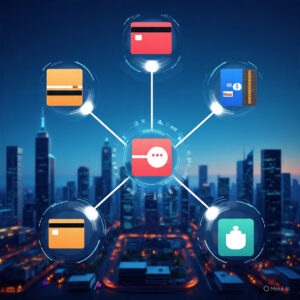Why AI is Not a Threat to Humanity: Embracing a Future of Collaboration

Artificial intelligence (AI) has been a subject of intrigue and sometimes concern for years, portrayed in media and popular discourse as either the driver of a utopian future or a potential threat to humanity. As AI systems become more advanced, conversations about their implications for jobs, privacy, and even humanity’s survival have intensified. However, these concerns often overlook the primary way in which AI is being developed and applied today—not as an autonomous force seeking to replace us, but as a collaborative tool designed to complement and enhance human capabilities. When understood and implemented wisely, AI holds more promise as a partner than as a threat.
1. AI as an Enhancement, Not a Replacement
The design and purpose of AI are to enhance human abilities, not to replace them. AI is incredibly adept at processing large amounts of data, recognizing patterns, and making calculations faster than any human could. However, it lacks the creativity, intuition, and ethical judgment that come naturally to people. For example, AI algorithms in healthcare assist doctors by analyzing vast medical datasets and suggesting potential diagnoses or treatment options. These systems don’t replace medical professionals; rather, they support them, improving diagnostic accuracy and enabling faster, more personalized patient care.
Similarly, in fields such as finance, education, and even the arts, AI is used to handle repetitive tasks or analyze complex datasets, allowing human professionals to focus on tasks that require creativity, decision-making, and interpersonal skills. This symbiosis between AI and human expertise enables a higher level of productivity and innovation than either could achieve alone.
2. AI as a Tool, Guided by Human Values
One of the most critical aspects of AI development is that it is inherently shaped by human intentions, ethics, and values. AI systems are designed, programmed, and monitored by people who set the parameters within which these systems operate. For instance, AI used in criminal justice systems is developed with strict guidelines to ensure fairness and transparency. By embedding ethical considerations into the design of AI systems, we can prevent misuse and ensure that AI aligns with societal values.
AI also depends on the data it’s trained on, which allows humans to influence its behavior. As a result, AI doesn’t act independently of us—it relies on us to guide its development, interpret its outputs, and apply its insights responsibly. This ability to shape AI provides an added layer of security, as we can continuously refine these systems to address ethical concerns, reduce biases, and ensure their alignment with human priorities.
3. The Human Element in AI Decisions
AI can process data and make predictions, but it cannot replace the nuanced understanding of context, emotion, and ethics that humans bring to decision-making. Take, for example, the use of AI in hiring. AI can screen resumes and suggest candidates based on qualifications and experience, but it cannot evaluate a candidate’s character, passion, or potential for growth. Final hiring decisions still rest with human managers who can consider the broader context of a candidate’s suitability for a role.
Furthermore, complex ethical decisions—such as those in law, healthcare, and governance—require a moral compass and societal consensus, which AI lacks. Humans remain central to the oversight and interpretation of AI’s recommendations, ensuring that decisions are made with empathy and a sense of justice that machines simply do not possess.
4. Job Transformation, Not Job Replacement
One of the most common fears associated with AI is job loss. While it’s true that AI will automate certain tasks, historical evidence shows that technological advancements more often lead to job transformation rather than widespread unemployment. When the internet emerged, for example, many worried it would replace traditional media, retail, and communication jobs. Instead, it created entirely new industries and job roles—think of digital marketing, app development, and e-commerce—which wouldn’t exist without internet technology.
AI will similarly give rise to new fields and job roles. Already, demand is growing for AI ethicists, machine learning engineers, data scientists, and AI compliance officers—jobs that were virtually unheard of just a decade ago. Moreover, by automating repetitive tasks, AI frees up human workers to focus on strategic, creative, and interpersonal aspects of their jobs. The end result is a more dynamic, fulfilling work environment where people can focus on roles that require distinctly human skills.
5. AI and Humanity’s Shared Progress
AI has the potential to accelerate progress on some of humanity’s biggest challenges, from climate change to disease eradication. In environmental science, AI is used to track deforestation, predict climate patterns, and optimize energy consumption. In medicine, AI-driven tools are helping scientists analyze genetic data to find treatments for complex diseases. AI’s ability to process and analyze massive datasets gives us new tools to address problems that were previously intractable.
In this sense, AI should not be viewed as a threat but as a powerful asset in the hands of humanity, capable of enhancing our ability to tackle global issues collaboratively. By positioning AI as a partner in solving shared challenges, we can focus on using this technology to build a better world for everyone.
6. Safeguards and Ethical Frameworks
To mitigate any potential risks associated with AI, governments, tech companies, and research institutions are working to develop comprehensive frameworks and ethical standards for AI development and deployment. These frameworks prioritize transparency, accountability, and fairness, ensuring that AI systems are used responsibly. Initiatives such as AI ethics committees, regulatory bodies, and international partnerships are in place to monitor AI’s development and prevent misuse.
For instance, the European Union has established guidelines for “Trustworthy AI,” which include principles like transparency, non-discrimination, and accountability. Many companies are also implementing internal guidelines to govern how AI is used and to ensure that their AI technologies are fair and transparent. With these safeguards, society can enjoy the benefits of AI while minimizing risks.
Conclusion: A Future of Human-AI Collaboration
AI is not here to replace us—it’s here to help us. When developed responsibly and used wisely, AI serves as a valuable tool that enhances our abilities, improves our quality of life, and accelerates our progress on challenges we couldn’t tackle alone. By embracing AI as a partner in our journey, we can create a future where technology and humanity work hand in hand to achieve extraordinary things.
Rather than fear AI, we should focus on building an ethical and inclusive approach to its development, ensuring that it reflects our values and serves the common good. By nurturing a mindset of collaboration, we can ensure that AI remains not a threat but an asset, empowering humanity to reach new heights.




